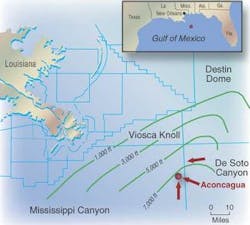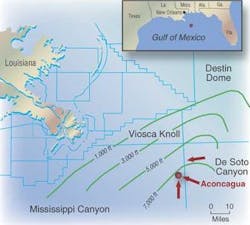Challenges in deepwater subsea well completion design and implementation
J. Piedras
Total E&P USA Inc.
G.P. Stimatz
Marathon Oil Co.
V.B. Jackson Nielsen
WellDynamics Inc.
G.M. Watson
Schlumberger
The subsea well completion design and implementation in Total's Aconcagua field and Marathon Oil Co.'s Camden Hills field posed unprecedented challenges.
Water depths in the area of planned development (to 7,209 ft) were greater than for any well previously completed. Limited gas reserves in this high-cost, deepwater environment precluded future economic intervention, so the completion design had to balance the potential complexity of multiple-zone production with high life-of-well reliability. Conducting the completions from a dynamically positioned (DP) drilling vessel, which had not yet been done at the time completion planning was underway, presented additional challenges.
The Aconcagua field in Mississippi Canyon block 305 is in the Gulf of Mexico about 140 mi southeast of New Orleans. Additionally, the Camden Hills field is adjacent on Mississippi Canyon block 348. These fields, along with the BP-operated King's Peak field, produce into the Canyon Express gathering and processing system. Produced gas from subsea wells in all three fields is conveyed 55 mi via dual pipelines to the host processing platform operated by Williams Energy Services, located in Main Pass block 261 and known as Canyon Station. The well completion budget comprised about 50% of the total project cost.
The producing reservoirs are a series of high permeability, unconsolidated sands, underlain in several cases by water-bearing sands. Experience has shown that wells completed in reservoirs of this nature will water-out very quickly once water production begins. The ability to drain the multiple gas sands and shut-off water production without intervention was a driver of the completion design.
The design of the high-rate deepwater gas producers eventually came to include stacked frac-pack sand control, pressure-operated fluid-loss/well control devices, and intelligent well completion equipment, with cleanup flow to temporary facilities on the rig. Completion work was conducted over a nine-month installation campaign from a dual-derrick DP drillship. Significant challenges were met and overcome, and numerous "firsts" for both the operators and the industry were established.
null
Development of Aconcagua and Camden Hills consisted of batch completion of six pre-drilled gas wells, and the completion work was conducted from the Transocean Discoverer Spirit drillship. Production startup occurred just after the sixth completion, and all wells are capable of producing at or above design rates (50 MMcf/d per well). Of equal importance to the well performance is the fact that all rig operations were conducted with a flawless safety and environmental record. No lost-time or US Occupa-tional Safety and Health Administra-tion-recordable incidents, environ- mental incidents, or US Minerals Management Service incidents of noncompliance were incurred.
Because of the tight economics of the field developments and scarcity of available personnel resources within each company, Total and Marathon agreed on a personnel-sharing arr-angement and formed the Wells Integrated Project Team joint group for the subsea tree installation and well completion design and implementation. Completion engineers, rig supervisors, and select contractors were co-located to develop the completion design and installation procedures beginning 15 months before the first completion.
Approximately four months before the planned start of rig operations, the Discoverer Spirit drillship was selected to conduct the completion operations. This was a change from the rig that previously had been identified for use in this campaign.
The Discoverer Spirit was well suited for conducting the well completion work. The rig is a state-of-the-art dual-derrick drillship with ample deck space for accommodating the support equipment of the numerous service companies.
It was recognized early that even the best-planned operations would not be successful without significant input from rig and service company personnel, during both the planning and execution phases of the project. Extensive pre-job project reviews and brainstorming sessions were held with all rig and service provider personnel. Rig and service personnel were included in safety/ environmental and performance bonus programs. Continuous improvement was promoted during operations by rewarding rig-based personnel for submitting the best idea of the week.
The WIPT took responsibility for the subsea trees from the Canyon Express project team after final quality assurance/quality control and system integration testing was complete. The original project schedule, developed in early 2000, envisioned the horizontal subsea trees being batch-set prior to beginning any well completion operations. This schedule assumed that all trees would be available to be run prior to beginning the first completion. However, delays in tree manufacturing and testing prevented all trees from being completed by the time the rig moved into the field.
The moonpool deck of the Discoverer Spirit provided ample room for subsea tree handling operations. At one time, there were four trees on the rig in various stages of deck testing before running. Special tree transportation carts allowed the trees to be moved from the testing/staging area to the moonpool beneath the aft rotary table.
The intervention and workover control system provided essential tree control functions and methanol injection capability during completion operations. The electro-hydraulic system's umbilical was designed to be run in three configurations: clamped to the tree running string, clamped to drilling riser connections, or lowered on a clump-weight. For these completions, the umbilical was run alongside the drilling riser.
Lower completion
Each of the six completions had at least two zones that were required to be selectively controlled from the host platform utilizing an intelligent well completion system (IWCS). The lower (or sandface) completion operations consisted of reentry and cleanout of the temporarily abandoned wellbore, tubing-conveyed perforating, sand control operations (including installation of formation isolation devices), and installation of an isolation packer assembly.
The lower (or sandface) completion operations consisted of reentry and cleanout of the temporarily abandoned wellbore, tubing-conveyed perforating, sand control operations (including installation of formation isolation devices), and installation of an isolation packer assembly.
The 4-1/2-in. outside diameter (OD), 15.5 ppf, S-135 tubing with premium two-step connections that was used as a workstring failed during the completion of the second well, Mississippi Canyon block 305 No. 2. The tubing, purchased new for this completion program, parted at the base of a pin about 3,000 ft from the top of the string while attempting to shift the service tool following pumping operations on the lower zone. Since light fluid was present in the tubing at this time, the well began to flow. The shear rams were closed to secure the well. The string parted a second time while it was being fished in the riser. Both failures occurred at tensile loads significantly less than the rated capacity of the pipe. The cause of the pipe failure is still uncertain.
Upper completion
The upper completion consisted of the following accessories run on the production tubing (from top to bottom):
- Tubing hanger
- Chemical injection mandrel (methanol)
- Surface-controlled subsurface safety valve (SCSSV)
- Chemical injection mandrel (scale inhibitor)
- IWCS
- Production seal assembly with shearable locator.
Hydraulic and electrical control lines were run to provide power and communication to the various devices. Cross-coupling protectors were installed on each tubing joint, and specialty clamps were run above and below the injection mandrels and the SCSSV. The formation isolation devices in the lower completion provided a secure, static wellbore while the upper completion was run.
The IWCS equipment consisted of a packer-setting sub, a retrievable production packer, a mandrel containing three sensors, and two control line-actuated interval control valves. The equipment was designed to allow either producing interval to be shut-in independently in the event of water encroachment during the production life. The interval control valves were hydraulically actuated through the subsea control system via the subsea control module on the tree.
Significant interface work was required be-tween the subsea control system supplier and the IWCS supplier. Development of a subsea gauge interface card was required by the IWCS provider to allow power and communication from the subsea control system to the downhole equipment.
Lessons learned
The challenges faced in completing the Aconcagua and Camden Hills wells in record-setting water depths were successfully met and overcome. Adequate planning time and resources must be allowed for a project of this complexity. A fulltime planning team, including service company personnel, is required. Having a planning team member who can focus on rig-related activities is essential. The completion team must be represented early in the subsea tree design and manufacturing process, and completion team members must be familiar with each other's responsibilities to provide adequate onshore and offshore backup support.
Early rig selection is important to identify and implement rig modifications in a timely manner. The adoption of a positive safety culture by all personnel was critical to achieving the project's safety performance. In addition, the personnel's ability to remain flexible and implement lessons learned on subsequent wells improved the schedule as the program progressed.
Contingency plans are equally important as primary plans. They must be fully thought-out, tested, and available to implement on the rig. Finally, project success depends on attention to detail on all equipment and procedures, not just the "high-tech" aspects.
Acknowledgements
The authors would like to thank the personnel of all the suppliers, service companies, consultants, and the drilling contractor, and the rig supervisors and WIPT members whose tireless efforts made this project possible. We would also like to thank all the Canyon Express interest owners (Total, Marathon, BP, Pioneer, and Nippon Oil Exploration USA Ltd.) for their support and permission to publish this work.
Editor's Note: This is a summary of OTC 15094.


